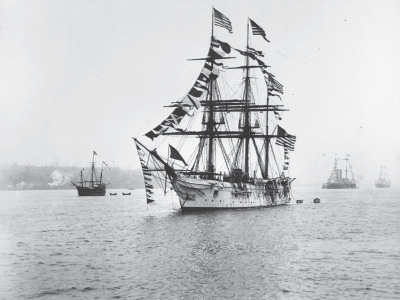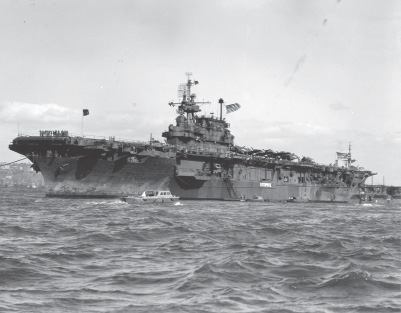A Sailor's History of the U.S. Navy (18 page)
Read A Sailor's History of the U.S. Navy Online
Authors: Thomas J. Cutler


The fourth USS
Enterprise
and HMS
Boxer
engaged in battle during the War of 1812. Seventeen-year-old William Barnes “wormed out the bore,” inserted the “wadding,” and manned the tackles while serving in one of the American ship's gun crews during the battle.
U.S. Naval Institute Photo Archive
Half-blinded by the smoke and coughing from the fumes, Barnes had just a few seconds to do his work before another Sailor would swab out the inside of the bore with a sponge fixed to a long pike to cool the chamber and douse any burning embers that might prematurely ignite the new powder charge. Another crew member followed with a fresh cartridge, a flannel bag that earlier had been carefully and precisely filled with explosive black powder by the ship's gunner down in the copper-lined magazine well below the ship's waterline. A twelve-year-old boy, known as a powder monkey, shuttled between the guns and the magazine, bringing fresh cartridges up from the magazine to replace those expended. Next down the bore went the 18-pound iron ball.
Barnes again stepped to the muzzle to force a hunk of wadding down the cannon's throat that prevented the ball from rolling out as the ship heaved and rolled in the seaway. He then helped several others man the tackles that were used to reposition the gun in the gun port. As Barnes heaved on the line with all his strengthâhis arms feeling as though they were coming out of his shoulder sockets, and his lungs burning from the pungent smoke-filled airâthe heavy gun rumbled forward into place. The gun captain quickly supervised the aiming of the weapon, which at this rangeâ“a half-pistol shot distance” as later described by McCall in his official reportârequired little adjustment. When the gun went off, Barnes felt as though someone had clapped him on both ears simultaneously.
The two ships hammered at one another for the better part of an hour. Twice during the engagement,
Enterprise
managed to cross
Boxer
's bow, a maneuver called
crossing the T
that is highly advantageous because it allows the crossing vessel to bring all the guns along her side to bear on her opponent's bow, where few if any guns can be positioned. After the second such crossing,
Boxer
's main topmast came crashing to the deck, bringing the main yard down with it. Continuing her murderous fire,
Enterprise
punched holes in
Boxer
's hull with well-placed round shot and shredded her sails with hailstorms of grapeshot. At about 1600,
Boxer
's guns fell silent, and a voice called across the water, “We have surrendered.” Using a
voice trumpet, McCall asked why
Boxer
had not struck her colors. The answer came back that her captain had nailed her ensign to the mast before the battle and ordered, “Do not let these colors come down while I still have life in my body.”
Three days later, young William Barnes made his way through the streets of Portland, Maine, as part of a large procession. He felt unsteady, as though the street were moving beneath his feet, an odd but common affliction among sailors who have spent long periods at sea upon decks constantly in motion. The whole town had turned out, and he couldn't help but smile when a tall man walking solemnly at his left flinched noticeably when a cannon went off out in the harbor. It was
Enterprise
firing a shot every minute in salute to the funeral procession. Full honors were being accorded the deceased.
The large entourage reached the Portland cemetery where everyone gathered around the gravesite as best they could. Barnes was fortunate to find a small hillock upon which to stand, giving him a good view. Over the heads of the town fathers and more senior members of
Enterprise
's crew, he could see a casket over which was draped an American flag, its fifteen stars and fifteen stripes bright in the morning sun. Next to it was a second casket, its flag also red, white, and blue, but the colors arranged in the combined crosses of Saints George, Andrew, and Patrick. William Burrows, captain of the brig USS
Enterprise,
whose dying words were “Never strike that flag,” and Samuel Blyth, captain of His Majesty's brig
Boxer,
who had told his crew, “Do not let these colors come down while I still have life in my body,” were being laid to rest side by side, where they would remain for the ages.
Successful in major engagements against the French, Barbary States, and Britain, the third
Enterprise
came to be known as “Lucky Little
Enterprise
” and continued her service after the War of 1812, fighting pirates, smugglers, and slavers, mostly in Caribbean waters. Though her luck seemed to have run out in 1823, when she ran aground in the West Indies and broke up, she had one last bit of good fortune in her. Even in that dark moment of her demise, not one of her crew was lost.
The fourth ship to bear the name
Enterprise
was a schooner commissioned in December 1831, who spent much of her time patrolling South American waters and made an around-the-world voyage in 1835â36. She was sold out of the Navy in 1845, and there would not be another
Enterprise
in the U.S. Navy until 1877, when a ship described as “a steam-powered
sloop of war, rigged as a bark” received the honored name. This fifth
Enterprise
also circumnavigated the Earth, serving in a naval hydrographic mission and bringing back a wealth of data that contributed much to our knowledge of the oceans. She ended her career as a training ship, first at the U.S. Naval Academy, then at a maritime school in Massachusetts. Sold in 1909, she was followed by the sixth
Enterprise,
a small motor patrol craft purchased by the Navy in 1916 to serve a homeland security role during World War I. She left the Navy in 1919.
For more than a century following the War of 1812, the name
Enterprise
seemed to have seen its greater days of glory. While the fourth, fifth, and sixth namesakes served honorably and well, they went the way of the great majority of naval vessels. In much the same way, many young Sailors sign on for great adventure, hoping for a moment of glory, but the laws of chance dictate that only a few will see their aspirations fulfilled; the rest must carry out the mundane and the routine, the vital yet unexciting tasks of patrolling, showing the flag, keeping watch, gathering information, serving as deterrent, waiting for the day of challenge that may never come. Yet their importance cannot be overstated; just as the policemen on patrol on an uneventful night are essential to the security and well-being of the neighborhood they are protecting, so the Navyâits ships and Sailorsâmust carry on during the quiet times in history. There may be no obvious glory, and the ongoing work may not seem as important as those crescendos of crisis that capture the imaginations of writers and moviemakers, but there could be no security, no glorious responses to those rare challenges, no continuation of American democracy, without the dedication of those who serve quietly and stand ready.

The fifth USS
Enterprise,
seen here in 1893. She was a steam-powered sloop of war who once sailed around the world.
U.S. Naval Institute Photo Archive
Such was the lot of the interim
Enterprise
s and the Sailors who manned them. But all of that would be turned around in ways Benedict Arnold and William Barnes could never have dreamed of when
Enterprise VII
sailed into the Pacific Ocean in the late 1930s.
Eighteen-year-old Alvin Kernan reported aboard
Enterprise
in November 1941. He later remembered his first encounter with her as he arrived in a boat dispatched from USS
Procyon,
the ship that had brought him from the West Coast of the United States to Pearl Harbor, Hawaii. “The
Enterprise
was tied up on the western side of Ford Island taking on fuel and bombs, and as the motor whaleboat came up under her counter on her seaward, port, side, she towered a hundred feet above us, grayish white, nearly nine hundred feet long, beautifully shaped despite her size. . . . It was a total and instant love affair with this great ship, never lost and never felt again in quite the same way for another.”
Commissioned in May 1938, this seventh
Enterprise
was one of the U.S. Navy's earliest aircraft carriers, as evidenced by her hull number, CV-6. It was a time when battleships were still considered supreme among naval vessels, and carriers were seen as supportive rather than primary in naval warfare. That was about to change.
Kernan was assigned to an aircraft squadron embarked in
Enterprise.
As a seaman second class, his duties would be unexciting at first. But that too would change.
On his first day aboard, Kernan wandered about the ship, “staring with wonder at the complicated machinery, stowage spaces, elevators, and spare planes tied up in the overhead of the vast hangar deck. It was all so extraordinarily busy, the Sailors in spotless white shorts and T-shirts rushing here and thereâa crew of nearly two thousandâthe public address system constantly blaring out bugle calls, the shrill of boatswain's whistles, and unintelligible orders to âhear this' or âhear that.'” By afternoon he was already at work, chipping paint off the three-foot links of the ship's anchor chain. It was hard work, particularly in the warm Hawaiian climate, and Kernan was glad when it was over so he could join the ordnance gang in his squadron to begin “learning the ropes.” Being an inexperienced striker, he was paired up with a veteran petty officer, and together they were responsible for three of the Devastator torpedo bombersâbelting ammunition, fuzing bombs, moving torpedoes around on special hydraulic trucks, changing bomb racks, and loading bombs and torpedoes onto the aircraft.

The seventh USS
Enterprise.
When he first saw her, Seaman Alvin Kernan described the aircraft carrier as “beautifully shaped despite her size.”
U.S. Naval Institute Photo Archive
His squadron was required to supply men for the flight deck crews, and, before long, Kernan was manhandling aircraft on the windswept deck, wearing a dark blue T-shirt and a canvas helmet dyed to match. His days began before dawn and ended after dark, pushing aircraft at a dead run from one spot to another in a seemingly endless choreography of launch and recovery. In years to come, catapults and tractors would come to carrier flight decks, but in 1941 the planes took to the air by the power of their engines and were moved about the deck by the muscles of men like Alvin Kernan. It was very hard work, less tedious than painting anchor chains but physically
demanding. And so very important: as events would later prove, battles would be won or lost by the relative skills of the flight deck crews on each side's carriers.
The long hours of training were paying off for
Enterprise.
Though barely three years old, the ship already had a good reputation as a “hard worker,” where discipline and training allowed few excuses, and results were paramount. In the fleet, ships competed for the coveted efficiency award, to earn the right to paint a large “E” on their superstructures.
Enterprise
's growing efficiency and her formal name soon earned her the nickname “Big E.”